Light sources in infrared photography are more critical than in conventional photography. The type of light (sunlight, tungsten, fluorescent, LED, shade, overcast sky), its intensity, reflection, and angle will have a bigger impact on infrared images than on visible-light images.
When subjects are illuminated, some wavelengths are absorbed while others are reflected. The reflected wavelengths are perceived as color. Without reflection, the object or scene will be black. Have you ever tried to detect colors in moonlight?

Photo by Scott Nelson.
Sunlight
The sun emits visible, infrared, and ultraviolet wavelengths. It is the primary source of infrared light. The sky emits little infrared light and appears dark.
“Much of the energy of an incandescent tungsten light is emitted as infrared.”
Tungsten
Set your camera to tungsten white balance when using an infrared-converted camera to shoot in tungsten light. Much of the energy of an incandescent tungsten light is emitted as infrared. For example, a 100 watt tungsten bulb emits only 1 watt of visible light, while emitting 99 watts of infrared. You can feel the heat of infrared more easily than you can see it.
But Wait!
Unfortunately, most of the infrared light is deep infrared and falls out of the range of digital camera sensitivity. To compensate, try setting a higher ISO or use a longer exposure (just expect to see more noise).
Fluorescent/LED
Fluorescent bulbs emit very little near infrared light. That said, color corrected/daylight-balanced fluorescent lighting can work for infrared portraiture. Warm versions of macro light rings and other LED units have been found to emit reasonable amounts of infrared. Experiment with new lighting technologies.
Electronic Flash and Strobe
Electronic flash and strobe units are good sources of infrared light. In some instances, flash and strobe can be even more powerful than sunlight and provide more infrared wavelengths than visible-light wavelengths.
Shade/Diffused/Overcast Light
Less infrared energy is available when working in low light and diffused light conditions than when shooting in full sun. If you find yourself working in one of these scenarios, more exposure compensation will be needed and your images will likely be soft.
The sun is the largest natural source of infrared radiation. Infrared energy is most visible in leaves and other green foliage, especially in spring and early summer months when photosynthesis is at its peak. Therefore, landscape images usually trump cityscapes for detection of the infrared footprint.
Aim to shoot infrared on sunny days when the sky is bright blue and there are clouds in the sky. Overcast, hazy days tend to make for lackluster, low-contrast images. Much of the “ahh” factor that comes from infrared is the effect of reflected light from a subject. Infrared loves reflected light that is available on blissful, sunshiny days.
October 7, 2014
Zaanse Schans, The Netherlands
Weather reports are rarely reliable in Holland. So even though the forecast called for rain, I hopped on a bus and took a 45 minute ride from Amsterdam to the tourist village of Zaanse Schans. Clouds overhead looked rather harmless when I got there, but in about thirty minutes the overcast doldrums turned into lake-forming rain.
I relate this story because it helps me recall the elation I felt when the clouds parted and I was presented with a perfect infrared sky. It was the perfect setting for experimenting with my mirrorless OM-D EM-5 full-spectrum, infrared-converted camera and three screw-on filters: an Ultra-Blue, a black & white filter, and a filter that allowed me to revert to capturing visible light.
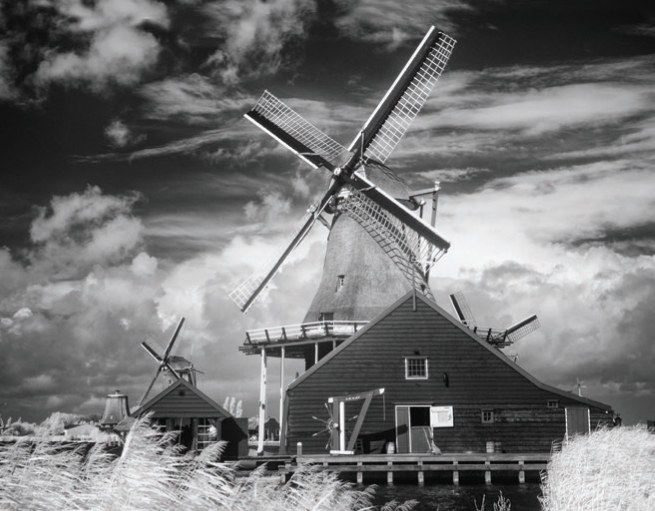
I quickly changed from black & white to color infrared by switching the lens filters and selecting an appropriate white balance.
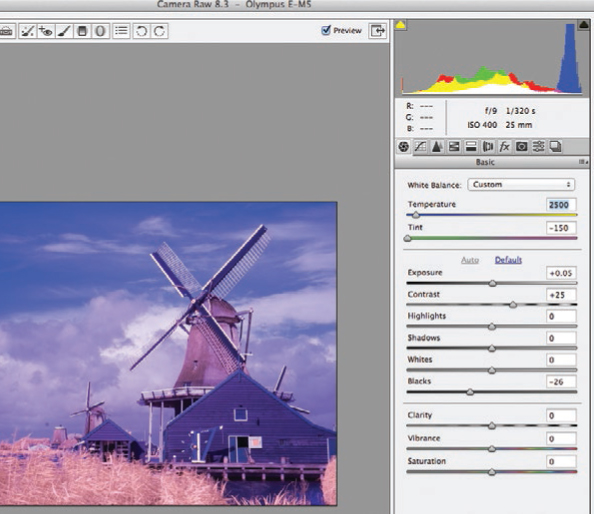
Changes were made to the color temperature and tint in Adobe Camera Raw.
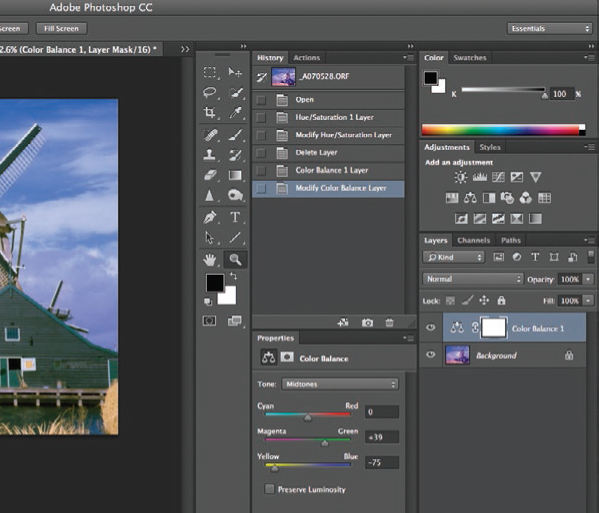
I adjusted the sliders in Photoshop’s Color Balance panel to bring in more yellow and green.

The color version of the scene (post-processed in Photoshop) looks very much like one captured at a normal visual wavelength. However, telltale infrared proof is in the light-colored foliage in the foreground and white treetops far in back. The tall reeds were actually a deep-green color, as my eyes saw them. Only minor adjustments were required in postproduction to bring out the colors shown here.
A high-key image concept (one in which the vast majority of tones in the image fall above middle gray) can be very successful in infrared. In these images, try to enhance the brightness as much as possible without sacrificing detail in the highlights.

Strange things are always happening in infrared images. This portrait was casually captured in a not-so-well-lit room. I was trying to create a black-hole look in the eyes but instead got nice (albeit grainy!) results. It is a photograph that the model really likes!

Towering white birch trees and white clouds created a potential for a pleasant high key image. The image was also processed with Nik Silver Efex. Finally, the noise in the image was reduced with the DeNoise plug-in by Topaz (www.topazlabs.com).
July 10, 2014
Holden, Utah
I often pull off of Utah’s main Interstate to see what lies in rural heartland country beyond the highway. In the small farming community of Holden, I found a plethora of photo ops, including barns, haystacks, and white horses. White on white was my vision for these equine sisters. I wasn’t disappointed. Storm clouds were brewing, and the lack of bright sun produced grain (an attribute of traditional infrared). I processed the images with Nik Silver Efex Pro, then used Topaz DeNoise to reduce the grain in the image.

Low key images are comprised of a majority of tones that are darker than middle gray. Storm clouds can deliver dark, brooding skies that can help support a low-key look and make for a moody image.

Bright sun did not dominate this image to provide the reflection that works so well in infrared, but stormy skies can also create a dramatic look.
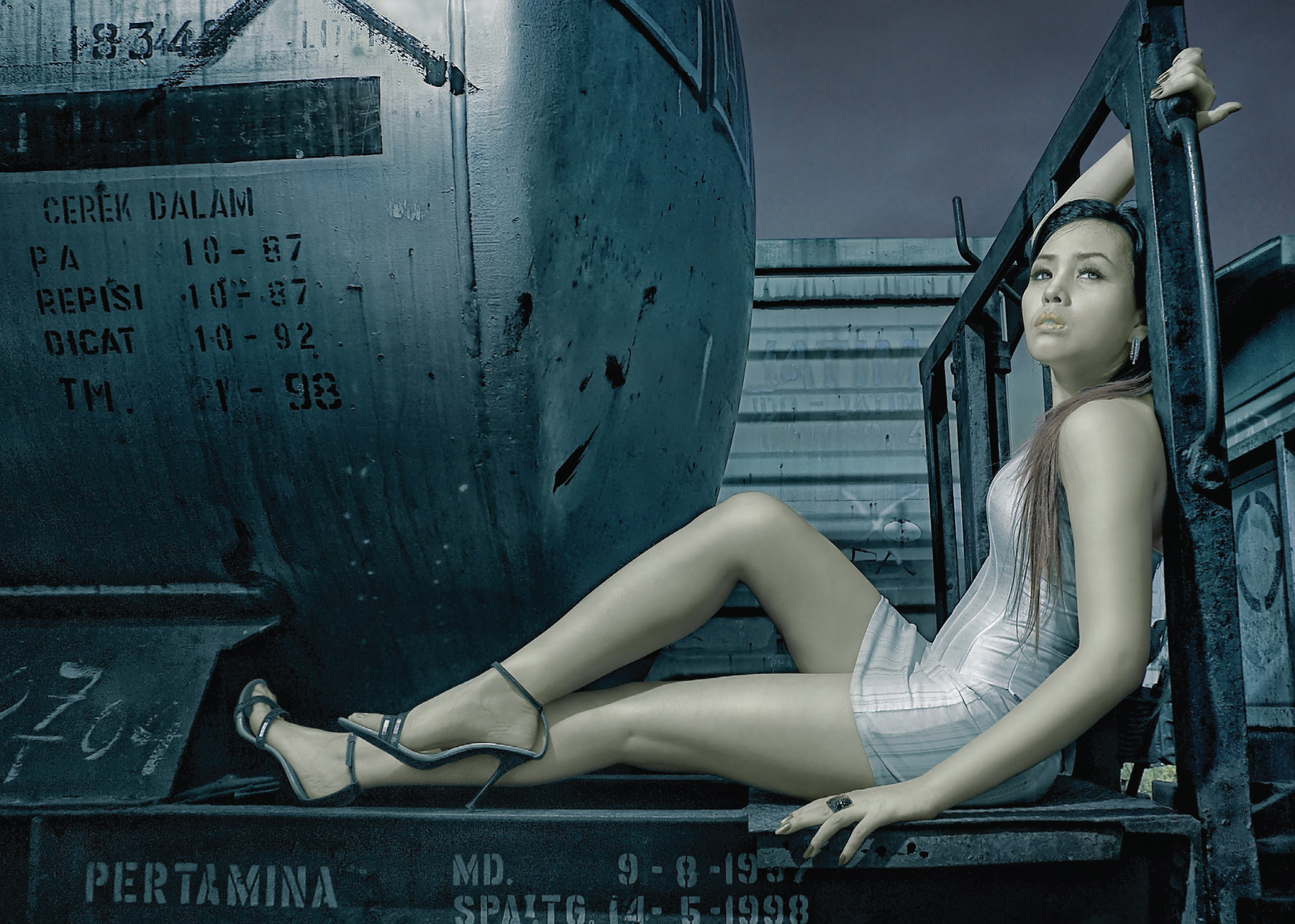
Oh, so dark and dreamy. In this image by Ikan Hiu Pegel Pegel, the model’s skin is silky smooth, but her eyes are sharp and well defined. Highlights on her dress and the metal provide extraordinary mood in the image.

There is dramatic contrast in this image by Ikan Hiu Pegel Pegel. Notice the model’s knee is pointed toward a hint of infrared blue coloring in the background.

Dark mountains (upper left) are balanced by the dark gate (lower right) with light-colored pasture in between.
Balancing Light and Dark Areas
While you are shooting, keep your eye on specific areas of the scene that you are recording that can balance one another. For instance, pairing dark mountains behind a light-colored field with a dark fence in the foreground can create balance. (Remember the dark and light tones in your images can be adjusted in postproduction for improved contrast.)
Flare from the sun is more pronounced with digital infrared than with film infrared. You can find a way to use it for creative effect or use a lens hood to decrease the odds that unwanted light will creep in and you’ll wind up asking yourself, “Now where did that flare come from?”
“Flare from the sun is more pronounced with digital infrared than with film infrared.”

Alex Morgan used lens flare to his advantage in this magical, ethereal shot of a bride and groom.
Shooting infrared at weddings is a challenge, mainly because you can’t count on having the best light available at the time of day the wedding planner has earmarked for photos. The sky may be overcast, clothing may reflect strangely, and uninvited living-dead guests may show up unexpectedly in your monitor because there was not enough light in the couple’s eyes during the shoot.
Beautiful and unique infrared images can be found in Alex Morgan’s wedding collection. He uses a Nikon D70 with a 720nm filter installed. He points out the interesting phenomenon of having at least one blue suit turn up in a portrait of groomsmen shot with infrared, even though normal vision showed them wearing all black.

Infrared can make a regular wedding look like a military event because of the apparent white stripe on the legs of the pants worn by formally attired males. Photo by Scott Nelson.

These groomsmen look mismatched. Sometimes, black fabrics may appear light or white, other times, it may stay black, as the eye sees it. Photo by Alex Morgan.
Tuxedos are usually trimmed with satin lapels, trouser stripes, and pocket liners. These embellishments will likely show up as white on a black tuxedo, as interpreted by infrared.

This bride and her sister were facing the low afternoon California sun. Their eyes are perfectly bright and look normal, instead of like black holes.

If the groom’s suit had reflected infrared light instead of absorbing it, this couple would appear as being both dressed in white—not the usual clothing combo for a wedding. Also, the bride’s eyes look perilously alien because her back is to the sun.
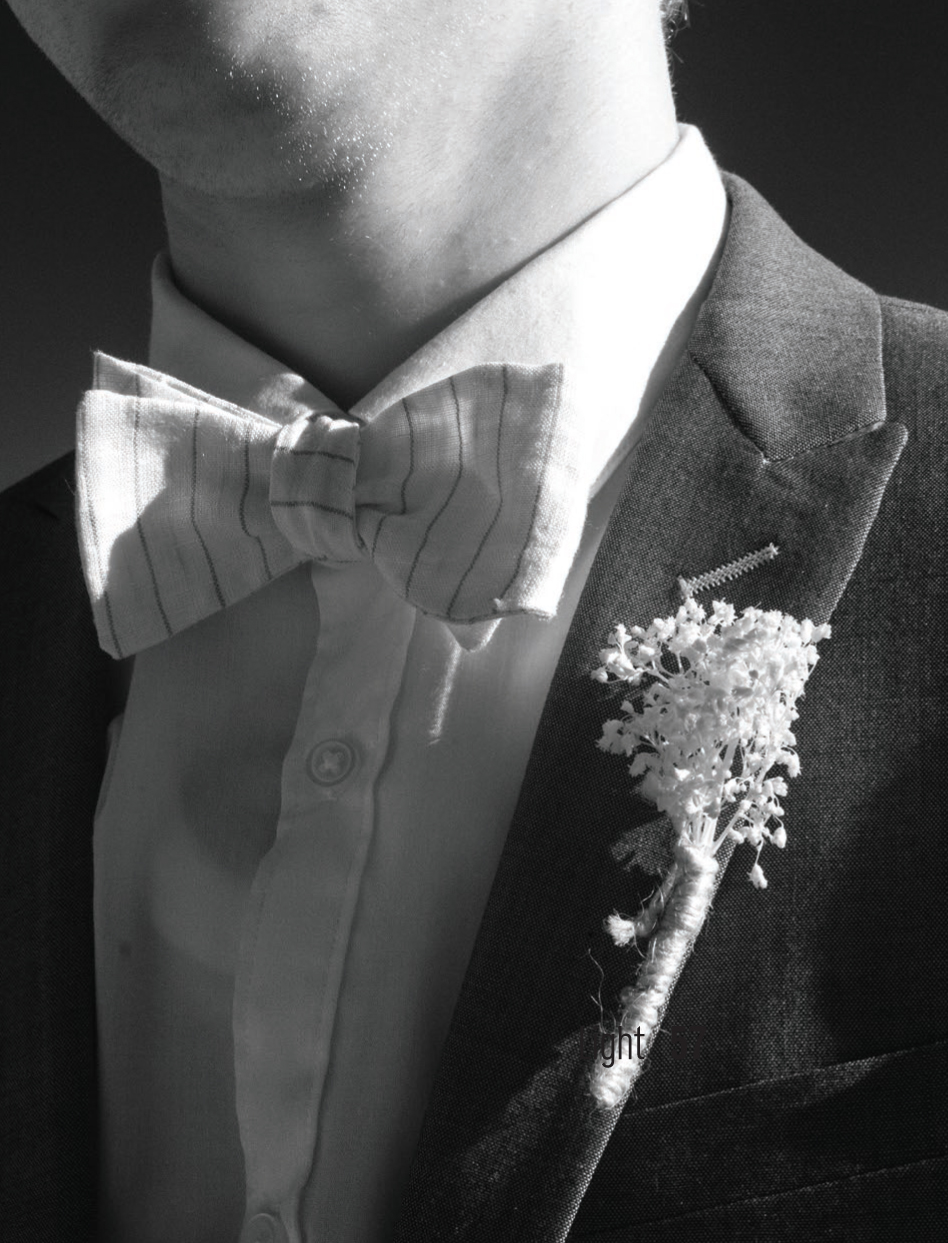
Fortunately, the groom’s suit remained dark due to the fiber’s favorable reaction to infrared. Notice the groom’s lapel, however. It was stitched in thread that reflects light, making it look inappropriately white on a black suit.